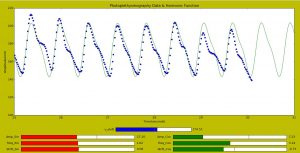It was programmed a second part of GUI. This part displays and analyse the bi-harmonic pulse, its first and second derivatives. It displays also important points on these curves, like the systolic and diastolic peaks, dicrotic notch, and other points on the first and second derivatives useful to determine vascular information.
The computed values displayed in this analysis results window are
-Systolic and Diastolic Peaks -Systolic-Diastolic Interval
-Systolic Amplitude -Augmentation Index
-Dicrotic Notch -Pulse Interval
-Crest Time -Vascular Age
-Arterial Stiffness Index -Vascular Aging Index
-Peripheral Resistance -APG Waveform Types
The next steps are:
-Improve GUI data reading and first data analysis capabilities. Improve algorithm to calculate vascular age. Create more efficient optimization algorithms to determine critical points. Include more harmonics in the analysis.




